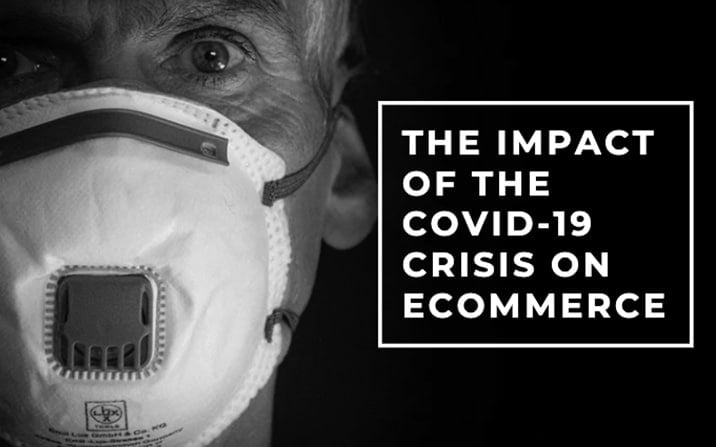Let me guess…
You are sick and tired of your soul-sucking 9-to-5 job, aren’t you?
And if I’m guessing correctly, you’ve just about had it with missing little Johnny’s Saturday baseball games or even spending time with your family — all because you have to work even on weekends.
Sigh…
You can’t help but ask yourself.
“Am I going to be stuck in work like this forever?”
“Am I ever going to get out of this rat-race?”
“How am I supposed to do that?”
At this point, you’re just itching to get rid of your fiendish day job and start living a new life where you have more control over your time — all while you having the capability to make mounds of cash.
We get it.
And we’re glad that you’re here.
That’s precisely the reason why we’ve put together this comprehensive guide on selling online.
how to sell products online?
The principles and strategies we included in this guide are the classic workhorses that successful online sellers use to make six to seven-figure incomes.
If you get these points down, or if you really put them to heart (and to action), you are bound to succeed in selling products online and making a killing.
What you’ll learn in this article
- 1 How to Successfully Sell Products Online – The Ultimate Guidelines
- 2 Prepare Compelling Marketing Materials
- 2.1 Add a Scarcity Element
- 2.2 Add Social Validation
- 2.3 Remind Your Audience of Their most Frustrating Pain Points
- 2.4 Be Strategic about Where and How to Add Your Call-to-Action
- 2.5 Make Sure your Offer is Highly Relevant
- 2.6 Be Mindful of Seasonality
- 2.7 Makes Sure Your Graphics have a Very Strong Level of Polish
- 3 What’s next?
How to Successfully Sell Products Online – The Ultimate Guidelines
I could write an entire novel about what you need to succeed in selling online. However, if we are to distil the points into a handful of principles, the points below are going to be it:
- The right mindset.
- Finding the right audience.
- Finding the right product.
- Finding the right platform.
- The right marketing method.
- Prepare compelling marketing materials.
Let’s give each point a closer look.
What You Need to Know to Succeed at Selling Stuff Online
The Right Mindset
Remember, if you don’t give up, then the battle hasn’t ended — you haven’t lost just yet.
Having the I-will-never-give-up frame of mind is crucial because as you journey towards making money through online selling, buy american xanax online you’ll find out that a lot of the strategies that you think will work will end up becoming a total flop.
You either get ignored.
Or the people will straight-up bash you for what you’re doing.
It’s during these moments when you’ll feel the most discouraged.
Don’t let it get to you.
Just dust yourself off and continue moving forward.
No matter how small the step, just continue moving forward — you’ll get there.
If you don’t give up, then you’re still in the game; therefore, you still have a chance of winning.
Just regroup, go back to the drawing board with the new knowledge and wisdom that you garnered from your most recent “defeat,” and come up with an even better strategy.
Keep on doing that, and it will only be a matter of time before you succeed in selling products on the internet.
You’ll be amazed at where persistence and having an unquenchable hunger for knowledge can take you.
Find The Right Audience
Without knowing who your prospective customers really are, you’ll never be able to sell online effectively.
If anything, you might end up spending thousands of dollars marketing to the wrong audience — these are the people who have zero interest in your products.
If you don’t want to waste your precious time, energy, and budget — plus get excellent returns for your selling efforts — you’ll need to zero in on who your potential customers are and how you can connect with them.
An excellent approach to having a crystal clear picture of who your target customers are is to create a buyer persona.
You can think of your buyer persona as a semi-fictional depiction of your ideal customer.
The information you’ll add in your buyer persona should be based on real data about your existing buyers and market research
To help you put together your buyer persona, here are some of the crucial questions that you need to answer:
- What are their age, sex, and educational attainment?
- Which city, state, or country are they from?
- What is their profession? How about their specific roles and responsibilities in their companies?
- What are their most pressing issues or problems? (As it pertains to your industry.)
- What mobile devices do they use?
- What competing products are they using right now?
- What time do they often go online?
- What goals are they trying to achieve? What is their ideal scenario when dealing with the problems they shared?
These are just some of the many questions that you can ask to learn more about your target audience.
Once you’ve gathered ample data about your audience, you can start building your buyer persona using free online tools.
Hubspot’s MakeMyPersona is an excellent tool for this.
After filling out the details about your buyer persona, you will then get a profile of your created ideal customer.
With a buyer persona, you’ll get to know who your ideal customers are and understand their pain points — which helps make it easier for you to structure and provide context to your content.
Establishing buyer personas will also help you develop strategies that are aligned across your business to attract leads, relevant visitors, and customers to your online selling site.
Another approach to learning more about your prospective customers is to use Facebook Insights.
The tool will help you get insights and aggregate information on your target audience, including purchase behavior, geography, demographics, and more.
Let’s say you want to increase awareness of your brand that’s all about trucking, and you want to check whether or not you have enough audience in the United States.
You can go to the Audience Insights page, type in “United States” under the “Location” section, and enter relevant keywords to your industry in the search box, etc.
For instance, in the screenshot below, I used these as parameters:
- People living in the United States.
- I entered the keyword “trucking.”
- I went with men and women.
- I the age to 25 and above.
These are some of the data points shown in the results.
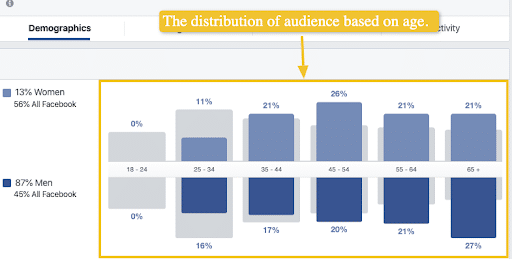
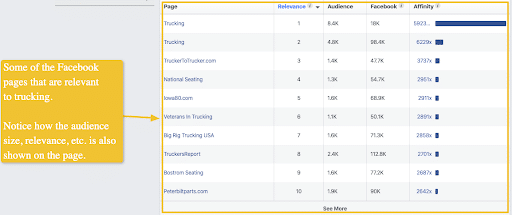
Looking at the data, you can obtain some insights about the demographics.
I’d like to point out that the Audience Insights tool has several more sections.
It can show your audiences’ location, the devices they’re using, their activities, etc.
These crucial bits of information can help you create a marketing strategy and offer that resonates with your audience.
Find The Right Product
To help you find the best things to sell online, you’ll need to find a specific niche first. After all, you can’t just sell anything and everything.
Without concentrating on a particular niche or niche products, you won’t be able to focus your marketing strategies for selling items that appeal to your specific target market.
Plus, without a specific niche, there’s a good chance you’ll be spread too thin when it comes to audience targeting, product research, etc. — making you far less effective at selling online.
Although your niche product should be distinguishable and unique (to an extent) from other products, you’ll need to ensure that there is a demand or, at least, interest for it first.
With tools like Google Trends, you can check the popularity of your product idea and check whether it is something that people look for.
Just type in your search term or topic, and the tool will show you the trend of user interest over time.
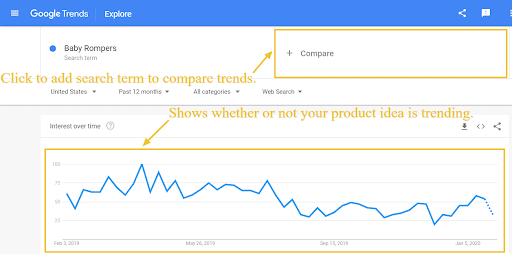
You can also add other search terms to compare the trends of your product ideas and check which one gets more interest.
The tool will also help you determine the seasonality of your product.
Let’s say you want to sell snow boots.
By checking the peak and low seasons of your product idea, you can plan your strategies for selling online accordingly.
For instance, you can sell snow boots from November to February and sell different types of footwear for the other seasons of the year.
This way, you can avoid selling products when they’re off-season and come up with the right strategies to still get profit when your products go through seasonal shifts.
Another way of finding niche products is by carefully studying your buyer persona.
We’ve discussed earlier how creating your buyer persona will give you insights about your ideal customer’s problems.
That being said, what you need to do is find a product that addresses your target market’s pain points.
Think about their problems and look for products that can solve them.
The more painful the problem your product can address, the higher your chances are of getting truckloads of sales when you start promoting your product.
To get more insights on whether or not your product idea will sell, you can go on other ecommerce websites and check out customer reviews for similar products.
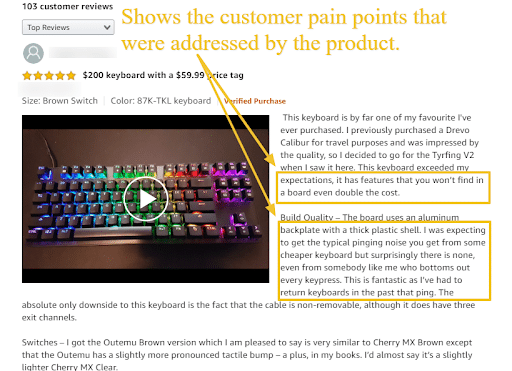
In the screenshot above, the customer left a review pointing out the specific problems that he or she has had with other similar products that this particular product was able to address.
Customer comments and reviews like this will help you determine the possible pain points of your target market. Uncovering their pain points will help you discover your next winning product.
It’s a great way of validating if your product idea is worth selling and assessing how you can use that value for your messaging and marketing strategies to ultimately sell online successfully.
Find The Right Platform
There is a myriad of online selling websites you can work with to “house” your online store.
However, it’s worth pointing out that not all platforms are created equal.
Some don’t possess the functionalities that will match your business needs, so you’ll need to look into the key features and benefits that each platform has to offer.
An excellent approach to help you cut down on time looking for the right platform is by checking out online reviews to compare features, functionalities, pricing, and more.
Below, we’re also going to look at some of the most reliable platforms and talk about their key features/functionalities.
Shopify
Shopify offers a fully-integrated ecommerce platform and solution for all kinds of ecommerce — whether goods or services.
The platform lets you set up your online store easily and quickly with its library of customizable website themes and without the need for hard coding.
Using Shopify’s interface, you can customize the look of your online selling site, monitor and respond to orders, organize your products, accept credit cards and online payments, and more.
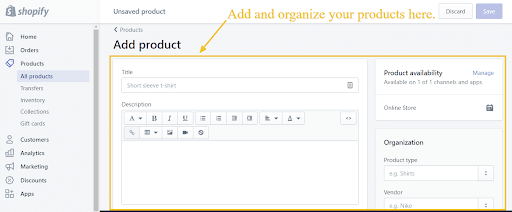
Some of the benefits of using Shopify include its many partners that can offer support, multi-channel retailing through offline, online, and social channels, plus, it’s fully-hosted.
Kajabi
Kajabi offers an all-in-one solution for marketing, selling, and delivering your digital products. If you’re selling online courses, then Kajabi might be the platform for you.
The platform offers features that let you easily create your online courses, design your online selling site with a website builder, build your landing pages, and launch your marketing campaigns.

With the platform’s features — including pre-made marketing pipelines, and easy-to-use interface, configuring and customizing your online courses can be less of a time-suck.
Kajabi’s marketing automation tools will also help you segment your customers, send out emails based on triggers you can configure, send branded messages (among other things).
If you already have an existing website for selling stuff online, and you’re just venturing out into online courses, the platform can still prove useful since it can get everything you need under one roof.
Amazon
Amazon, the most prominent and well-known selling website right now. And rightly so, due to its wide range of product offerings and ease of use for shoppers.
Because of how established Amazon is, selling on the platform can bring your products to a broader customer base and helps with your reputation as an online seller.
The platform provides key tools and applications that help you sell your products on the Amazon marketplace.
Plus, the platform offers a seller university that gives free tutorials to help you through the process of adding products, managing prices, fulfilling your orders, and more.
What makes selling on Amazon a pretty straightforward and quick process is you won’t need to set up your online selling website and warehousing infrastructure.
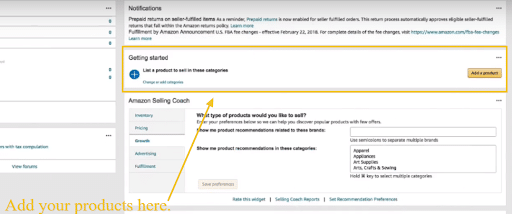
You can easily get your online selling started by creating your product listing, sending your inventory to a Fulfillment by Amazon (FBA) warehouse, and you’re ready to start selling stuff online.
By checking out the features and functionalities of various platforms, you can assess whether or not a specific selling site can help you achieve your goal of making money online.
Use The Right Marketing Method
One of the great things about online selling is you can be as creative as you want with promoting your products — and there are so many tried and tested, and even new ways to do it.
The challenge, however, is finding the best methods to market your products that will be worth the investment of your time, effort, and financial resources.
In other words, you’ll need to use the right marketing methods — those that can give you excellent returns. Otherwise, you’ll be wasting money on product promotion efforts.
Although there isn’t a perfect way to market your products, there are various marketing methods that can help you drive relevant traffic to your website, attract the attention of your target market, and create content order soma product online that will resonate with your potential customers.
For instance, you can run Facebook ads and create campaigns for your brand and products.
Facebook ads offer simple self-service tools to build your campaigns and other features that will help you monitor the performance of your ads through easy-to-read reports.
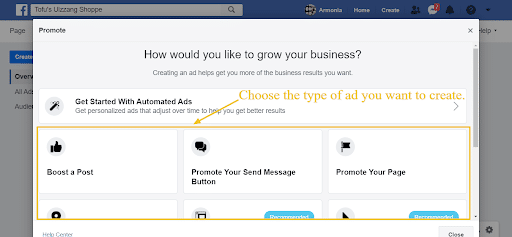
With the Ads Manager, you’ll have access to a unified ads creation tool that lets you make, publish, and buy ads on Instagram, Messenger, Facebook, Audience Network, and family of services and apps.
Another marketing method that even some of the biggest brands use is influencer marketing.
Through this marketing approach, you get to work with influencers to help promote your brand and products.
To help ensure the success of your influencer marketing campaign, you’ll need to find the right influencer to work with — that is, someone who works in or has experience working in your niche.
You can use online tools like an influencer.Co to find the right influencers to work with by typing in the category, location, and the number of Instagram followers.
Using the tool’s advanced search option, you can set filters to help narrow down your search, including the influencers’ number of followers on platforms like Twitter, Facebook page likes, Instagram engagement rate, and more.
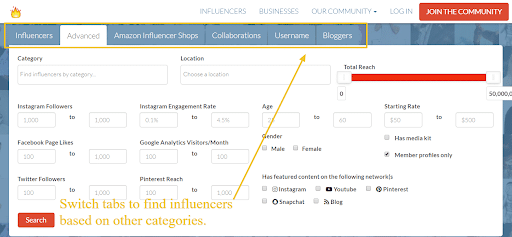
With this kind of search tool, you can save time manually searching for potential influencers, and instead, focus on creating content for your marketing campaign.
Finding the right kind of marketing methods for selling online and making money can require a bit of trial and error, but once you get the hang of it, you can get tons of returns for your efforts.
It’s also always important to go back to your marketing goals and use them as a basis for choosing the right marketing method to sell online effectively.
Prepare Compelling Marketing Materials
If you’ve gone this far, building the right mindset and finding the best audience, product, platform, and marketing method, you’re doing great.
However, you should know that none of those points mentioned above will work if you have low-quality marketing materials — or, at the very least, you’d be far less effective when you sell online with crappy marketing materials.
You need to create marketing materials that powerfully compel your readers to respond to your sales offers.
Without compelling advertising copy, landing pages, or any other collaterals, you’ll have a hard time convincing your audience to buy.
Here are some points that you can consider when creating your marketing materials so you can sell better.
Add a Scarcity Element
The fear of lack or missing out is one of the most powerful emotions because it spurs people to act i-m-m-e-d-i-a-t-e-l-y.
Whether it’s the latest fashion trend, exclusive packages, or others, people will consider taking the chance right away when they know that resources are limited.
As an online seller, you can leverage that fear by using scarcity elements in your marketing materials.
You can use countdown timers to show how much time your readers have left to avail of your limited time offers or discounts.
Here’s an example by 1-800 Flowers:

You can also project scarcity by showing the number of products remaining in the inventory like AliExpress does it.
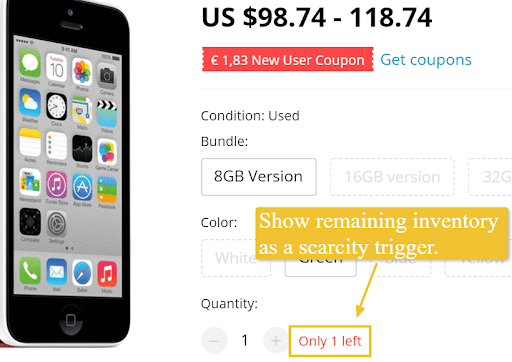
With scarcity triggers in your marketing materials, you compel your readers to act and buy immediately so that they won’t regret the lost opportunity later on.
Add Social Validation
Nowadays, shoppers want to make sure that the product they’re about to purchase has good quality.
That is why, if you want to be able to sell your products, your store needs to have “signals” or elements that would lead your audience to think that your products are worth buying.
You can do this by adding social validation elements to your marketing materials.
Include positive comments and reviews, and even high-star ratings, for instance, as Amazon did:
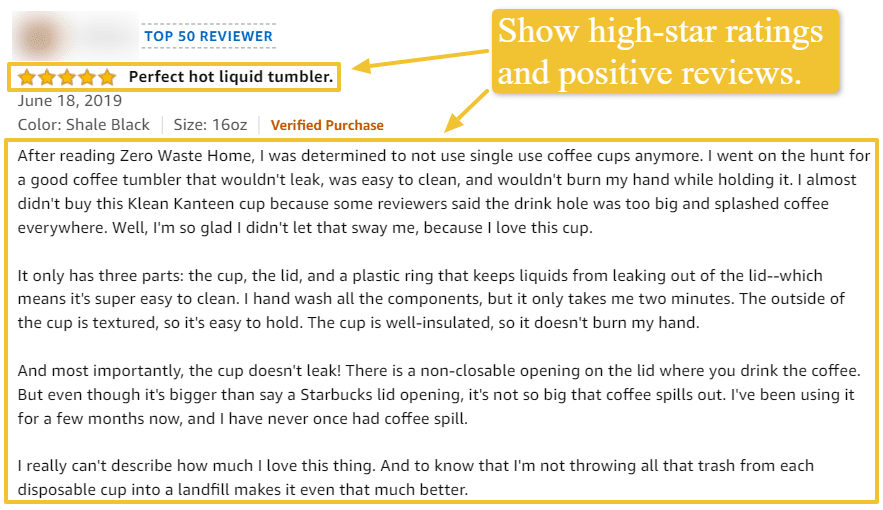
You can also showcase brands that have trusted your products or review excerpts that appeared in famous magazines. Here’s an example by ambsn.
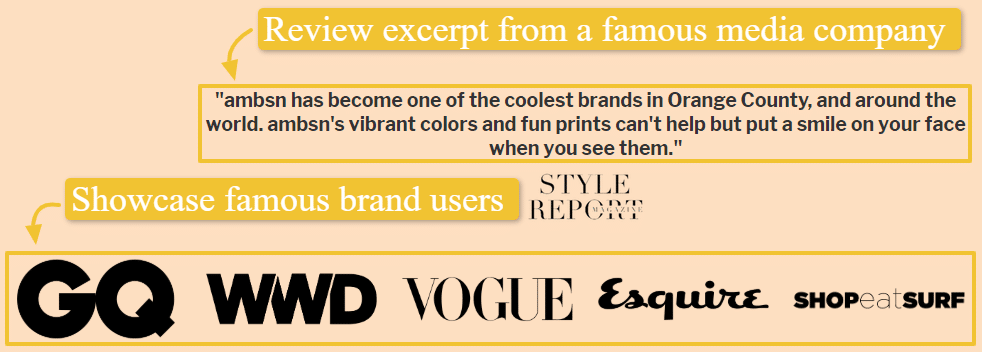
You can even post the testimonials shared by first-time or regular customers, prominent individuals, or companies, as well as the number of sales you’ve made, actual activity on your site, and more.
Showing them on your homepage also lets your visitors immediately see people’s thoughts about your product, and you give a positive first impression upon their arrival at your online store.
Remind Your Audience of Their most Frustrating Pain Points
In the previous sections, I mentioned how you could derive your customers’ pain points from the buyer persona you’ve put together through audience research.
You can leverage those pain points and reinforce them in your marketing materials.
It’s critical that you mention these in your copy, so your readers are reminded of their arduous struggles, making them emotional and more inclined to take action.
After all, shoppers mostly base their buying decisions on emotion, not logic.
Describe their most pressing and frustrating problems and then introduce how your product can help solve all that, mentioning the features and specific pain points addressed.
Be Strategic about Where and How to Add Your Call-to-Action
How and where you place your call-to-action (CTA) buttons is crucial.
Your placements can spell the difference between your visitors ignoring your offers, or them making the purchase.
Ideally, your CTA buttons should be floating — that is, they remain visible even when your site visitors scroll down your page.
Floating CTA buttons help the idea of buying linger in your shoppers’ minds, slowly convincing and enticing them to respond.
AliExpress shows an example:
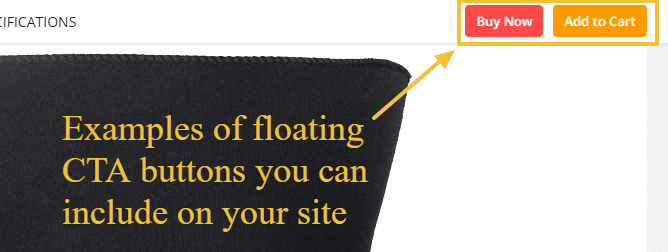
Another rule of thumb is to add your CTAs after you’ve added enough value.
While it is quite common and acceptable (it’s even considered a best practice) to have your CTAs above the fold, within your ad copy, you’ll be better off adding your CTAs after you’ve added value.
Relate with your visitors first by talking about their problems and pain points. Next, exhibit how your product can become the solution they’re looking for, and then insert your CTA button.
That way, when they see your CTA, they won’t look at you like some random sales dude.
You’d have already reminded them of their problems and also convinced them that you have the solution to their frustrations — making it easier to convince your visitors to take action on your offers.
Ideally, you should also only add one type of CTA on your page.
Avoid telling your visitors to buy, share, comment, and sign up at the same time.
Having a single CTA allows your shoppers to focus and avoid confusion. And it prevents them from experiencing analysis paralysis.
When they’re taking action on your CTA, you can then present another CTA.
For instance, after clicking making the purchase, you can show a pop-up telling your visitors to buy a related product.
Finally, make your CTA buttons “pop.“
Keep your text short and crisp, and use colors that don’t blend with the background.
Here’s how Patpat did it:
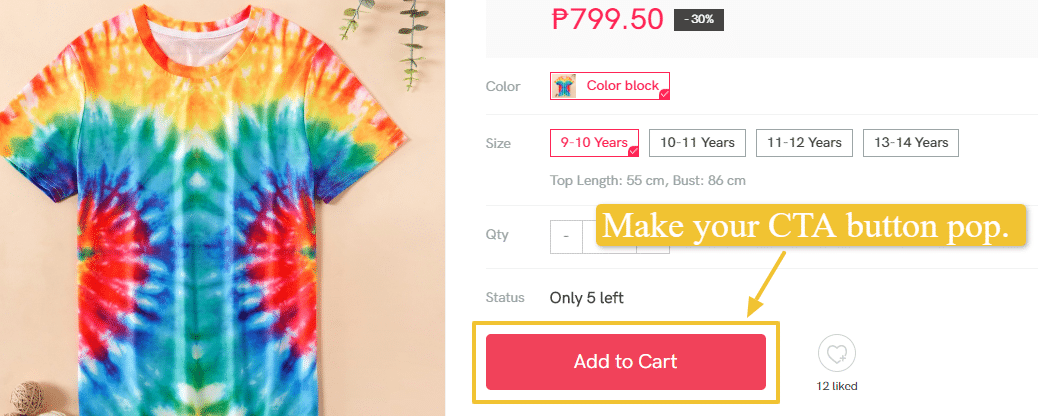
Patpat used a bright pink/red color when their pages’ background color is white.
They even added an ample amount of whitespace between their CTA buttons and other page elements. This emphasizes their CTA button and catches the attention of their readers more effectively.
The color also matches Patpat’s branding identity, complementing the colors in the online store, and making it more memorable for the visitors.
Make Sure your Offer is Highly Relevant
No matter how expensive and luxurious your offers are if they don’t resonate with your visitors, it’ll only be ignored.
It’s like selling the most expensive and feature-packed television to a blind person — the television becomes worthless.
When creating your offer, you need to think like your customers and ask, “What’s in it for me?”
You can then come up with offers that relate to your shoppers’ demographic profiles, interests, needs, and other factors.
Let’s say the offer you’re thinking of giving your buyers is free product shipping.
That may sound appealing, but if the people are buying from your local area, then the free shipping offer won’t be as enticing.
However, if your buyers are from the opposite side of the planet, then they’ll be more appreciative of the free shipping offer since they can avoid the hefty shipping fee.
Another example is you selling wedding dresses and offering swiss army knives as the freebie.
While a swiss army knife might be great, since you’re selling to ladies, they wouldn’t be so interested in the freebie.
The swiss army knife freebie would work well if you’re audience are doomsday preppers or those who are into outdoor activities.
Be Mindful of Seasonality
To make your marketing materials more compelling, you need to align them with people’s buying habits for the activities they participate in.
Seasonality also means you have to get into your customers’ heads and think about what drives them to make small and huge purchases at given periods in the year.
Although the holiday shopping seasons are clearly among the most profitable points, you likely earn much in other different times or months.
Thnk about the seasons or events that are important to your audience. You can then come up with occasion-specific products or sales and marketing strategies.
Makes Sure Your Graphics have a Very Strong Level of Polish
If you want your products to sell, you need professional-looking graphic designs — this bit is non-negotiable.
Here’s a thought…
How likely are you to take out your wallet, get your credit card details, and enter it into the ecommerce website’s billing page if their product image is blurry?
Highly unlikely, right?
I don’t blame you.
After all, with a blurry or less than stellar product photo, the ecommerce website is going to look VERY questionable and suspicious.
The audience would either think that the site is a scam, or the product might be of poor quality since the business owner can’t even afford to have a decent website with high-resolution product photos.
Whether your product photos are blurry, needs retouching, requires image masking, or background removal (among other things), you need to get it done. Otherwise, your low-quality product photos will wreck to oblivion whatever chance you have at succeeding in selling online.
If you’re like most ecommerce store owners, however, then I’m guessing that you are pressed for time.
You either don’t have the time to edit the photos yourself, or you know diddly squat about photoshop — leaving you no choice but to pay top dollar to graphic designers just so your photos would look crisp, clean, and professional.
That doesn’t always have to be the case…
If you are clueless about using photoshop or you don’t have the time to edit the photos yourself, then allow us to help you.
Depending on the type of service you need, the turn around time, the quantity, and the complexity of the photo that you want us to work on, you might only have to pay $0.29 for our service.
It’s THAT affordable.
Here’s an example of how our pricing works.
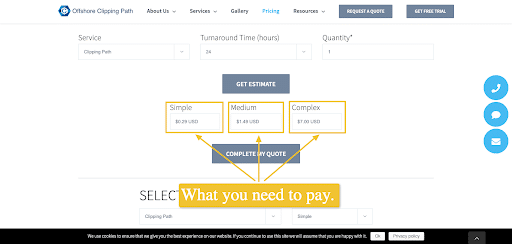
You can click this link to view our pricing calculator page.
At this point, I’m guessing that you’re happy with the price point that you saw.
Instead of paying a reliable graphic designer way over $20 per hour, you can have your photo done (in 24 hours) for only $0.29/image.
And so the question becomes, “How about the quality of your work?”
I’m glad you asked.
These are some of the designs that we’ve worked on.




Pretty sweet, huh?
As you can see, despite the affordable rates we’re offering, the best quality of our image editing service are top-notch.
We’re also proud (and very much humbled) to say that our clients love the quality of our work.
The reviews we garnered at Reviews.io are a testimony of this.
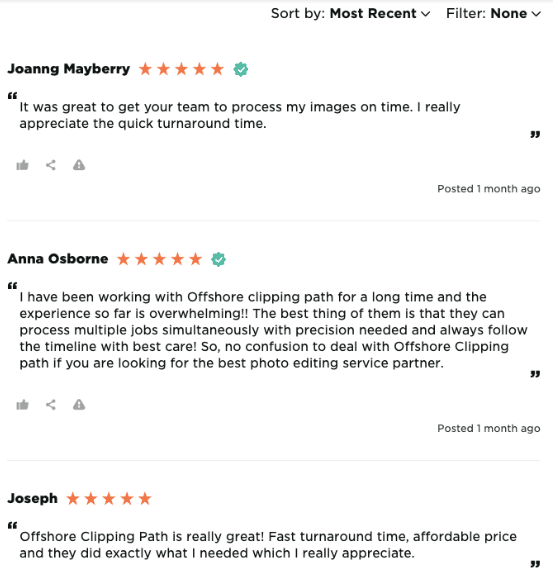
As you can see, with the help of our image editing services, you can forget about spending hours upon hours working on your product photos — we got you covered.
What’s more, you don’t have to break the bank to employ our services. With just a couple of cents, we can work on your product photos to make them look professional and “purchase-worthy.”
If you’d like to give our services a shot, click the button below to get a free trial.
What’s next?
Selling online doesn’t have to be complicated. You just need to have the right game plan and elements in place so you can have a thriving business.
— iThe points we shared above can help you with just that.
With these strategies, you can capture your audience more effectively, present irresistible offers, earn heaps of profit, and eventually boost your brand and competitive edge.
Using the right tools for all your strategies can also do wonders for you. That is why we shared some of the must-have tools in the guide.
Lastly, as you take steps to start selling online, be sure to remember the I-will-never-give-up mindset.
You need it.
Without it, you’ll never succeed.
If you found value in reading the guide, please take 3 seconds of your time to click the share buttons.
P.S. If you need help with your product photos or any type of photo-editing work, feel free to reach out to us or request a free quote.



